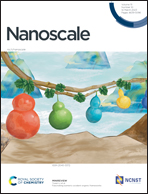Gas sensors based on the oxide skin of liquid indium†
Abstract
Various non-stratified two-dimensional (2D) materials can be obtained from liquid metal surfaces that are not naturally accessible. Homogenous nucleation on atomically flat interfaces of liquid metals with air produces unprecedented high-quality oxide layers that can be transferred onto desired substrates. The atomically flat and large areas provide large surface-to-volume ratios ideal for sensing applications. Versatile crucial applications of the liquid metal-derived 2D oxides have been realized; however, their gas-sensing properties remain largely underexplored. The cubic In2O3 structure, which is nonlayered, can be formed as an ultrathin layer on the surface of liquid indium during the self-limiting Cabrera-Mott oxidation process in the air. The morphology, crystal structure, and band structure of the harvested 2D In2O3 nanosheets from liquid indium are characterized. Sensing capability toward several gases, both inorganic and organic, entailing NO2, O2, NH3, H2, H2S, CO, and Methyl ethyl ketone (MEK) are explored. A high ohmic resistance change of 1974% at 10 ppm, fast response, and recovery times are observed for NO2 at an optimum temperature of 200 °C. The sensing fundamentals are investigated for NO2, and its performances and cross-selectivity to different gases are analyzed. The NO2 sensing response from room temperature to 300 °C has been measured and discussed, and stability after 24 hours of continuous operation is presented. The results demonstrate liquid metal-derived 2D oxides as promising materials for gas sensing applications.

- This article is part of the themed collection: Nanoscale 2023 Emerging Investigators


 Please wait while we load your content...
Please wait while we load your content...